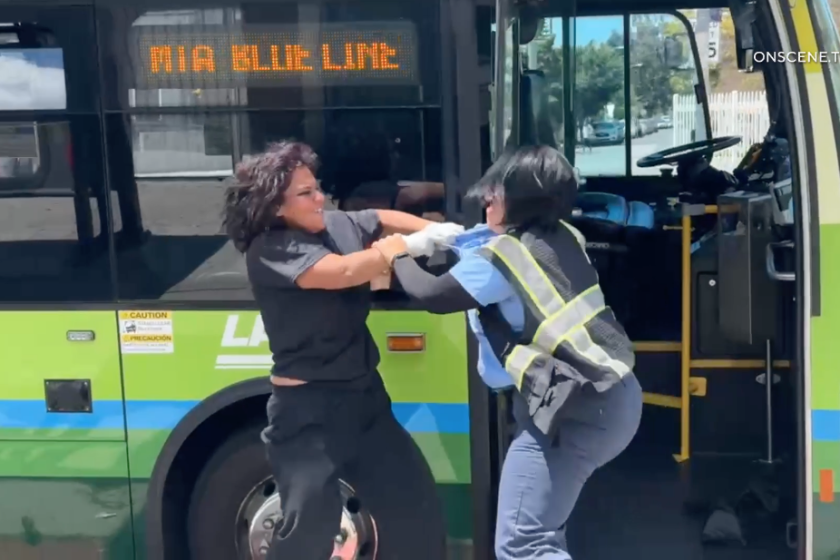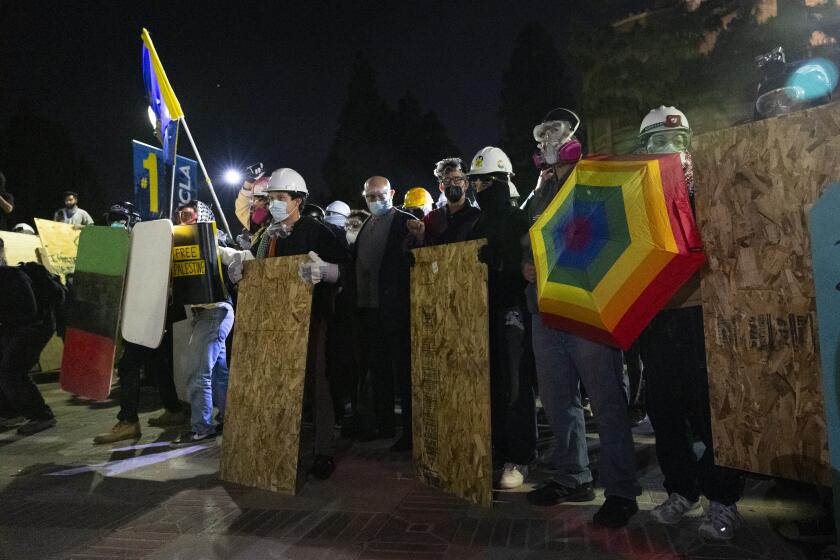As embers fly, patients and staff in dark
Although flames had chewed through the power lines that serve the Olive View-UCLA Medical Center, staff members thought that they would be fine. The hospital prided itself on its “state-of-the-art” backup systems.
But wind-whipped flames and choking smoke brought Olive View to a dark standstill early Saturday as the hospital lost power and its emergency generators failed.
“It was total darkness,” said hospital spokeswoman Carla Nino. “We had our flashlights. We went into our disaster mode.”
The Sylmar hospital was surrounded by tall, cyclonic walls of flame, as embers showered on the grounds and smoke seeped into the hospital’s lower floors. At times the smoke was so thick the beams of flashlights looked like headlights cutting through a fog.
The hospital, which opened in 1987, not only had a traditional backup generator but a self-contained power plant to create energy for several days in case of earthquake or other disaster. The precautions were born of experience -- the original hospital was leveled in the Sylmar earthquake in 1971 after being open just six months.
The hospital lost power at 1:45 a.m. Saturday, and the backup generator soon kicked in. The generator is designed to work as a bridge until the self-contained power plant, about 100 yards from the hospital’s eastern edge, fires up. The generator did its job, but the power plant didn’t -- a fuel pump failed.
“We don’t know why the fuel pump failed. It was tested as recently as Wednesday,” said Michael Wilson, spokesman for the Los Angeles County Department of Health Services. Hospital officials said they thought the pump was overcome by the heat and smoke.
The hospital was plunged into darkness, elevators stopped working and the machines that monitor patients’ vital signs went silent. Hospital staff and security guards quickly set up a makeshift command center on the second floor.
Huddled around flashlights, hospital managers and fire officials debated what to do. Some advocated evacuating the entire hospital. But where to send more than 200 patients? Others favored a wait-and-see approach.
As the staff pored over patient lists, asked other hospitals about bed space and contacted ambulance companies, a piercing alarm blared in the background.
In the end, 27 patients were evacuated: 18 babies from the neonatal intensive-care unit, four critical-care patients and five adults on ventilators. Staffers used hand-held resuscitation bags to help some patients breathe as paramedics carried them down flights of stairs on gurneys and then wheeled them to waiting ambulances.
As the flames tore through the hospital’s day-care center and administrative buildings on the outskirts of the grounds, workers tried to gather and calm the remaining patients. From the smell, one might have guessed the hospital itself was on fire.
“We tried to make sure they understand that it’s safer sheltering in place -- that if they weren’t well enough to be discharged, going out into the smoke is not a good thing,” Nino said.
Most patients stayed, but a handful, including mothers with newborns, grew so agitated that they checked themselves out against medical advice.
Smoke continued to choke the lower hallways, and the ventilation system was shut to stop the tainted air from making its way to patients on the third through sixth floors. Temperatures began to climb.
A woman in labor arrived. Computers and phones failed, and the hospital’s electronic drug-dispensing system stopped working, sending a pharmacist scurrying through stacks of medication with a flashlight.
“It did not create a major problem. No patients were compromised because of it,” Nino said. “It’s just something we didn’t expect.”
Some power returned about 4 a.m., and all power by 5 a.m. But the staff remained on high alert and prepared to evacuate in case the flames returned.
The failure of the power plant will be reviewed in coming days as the hospital evaluates its response to the fire.
Last month, the hospital braced itself when fires erupted in the San Fernando Valley, but the facility was unaffected. On Thursday, the hospital went through the Great Southern California Shakeout, a drill for a magnitude 7.8 earthquake.
--
seema.mehta@latimes.com
Times staff writer Garrett Therolf contributed to this report
More to Read
Start your day right
Sign up for Essential California for news, features and recommendations from the L.A. Times and beyond in your inbox six days a week.
You may occasionally receive promotional content from the Los Angeles Times.







